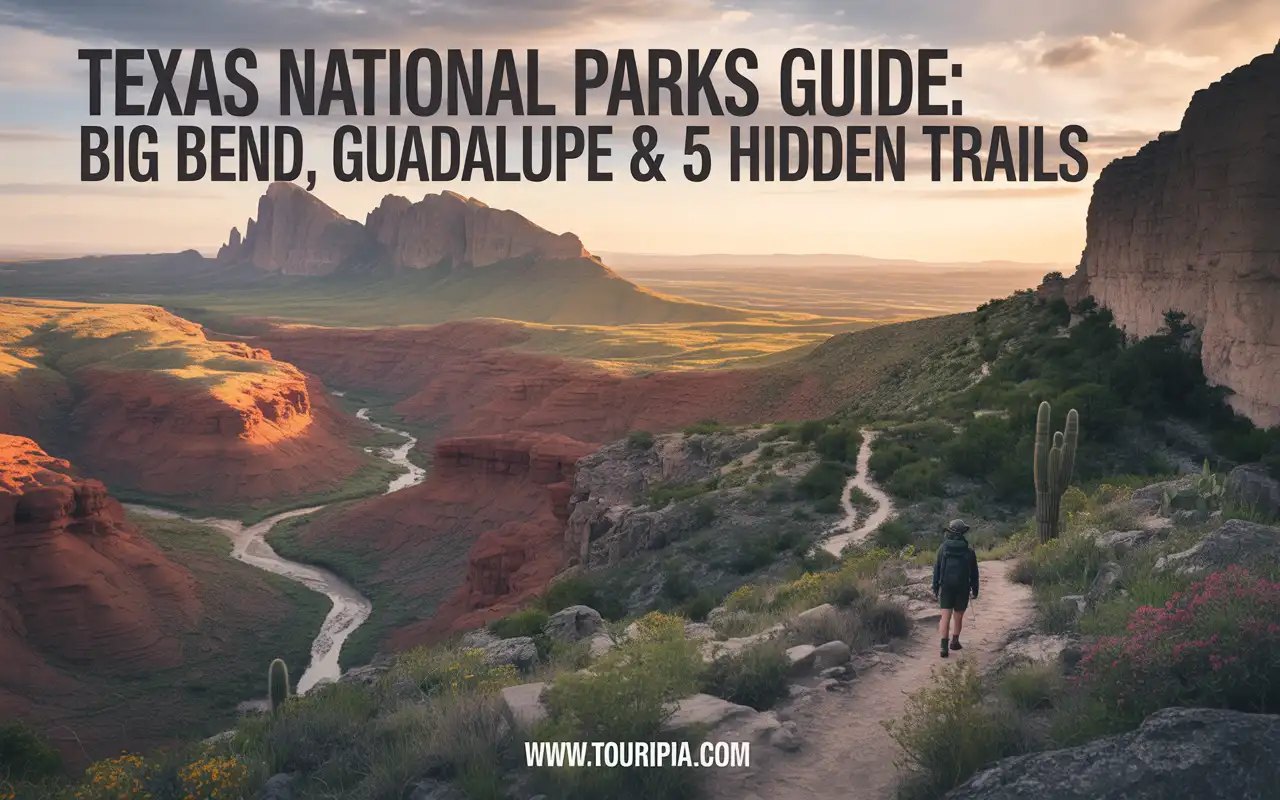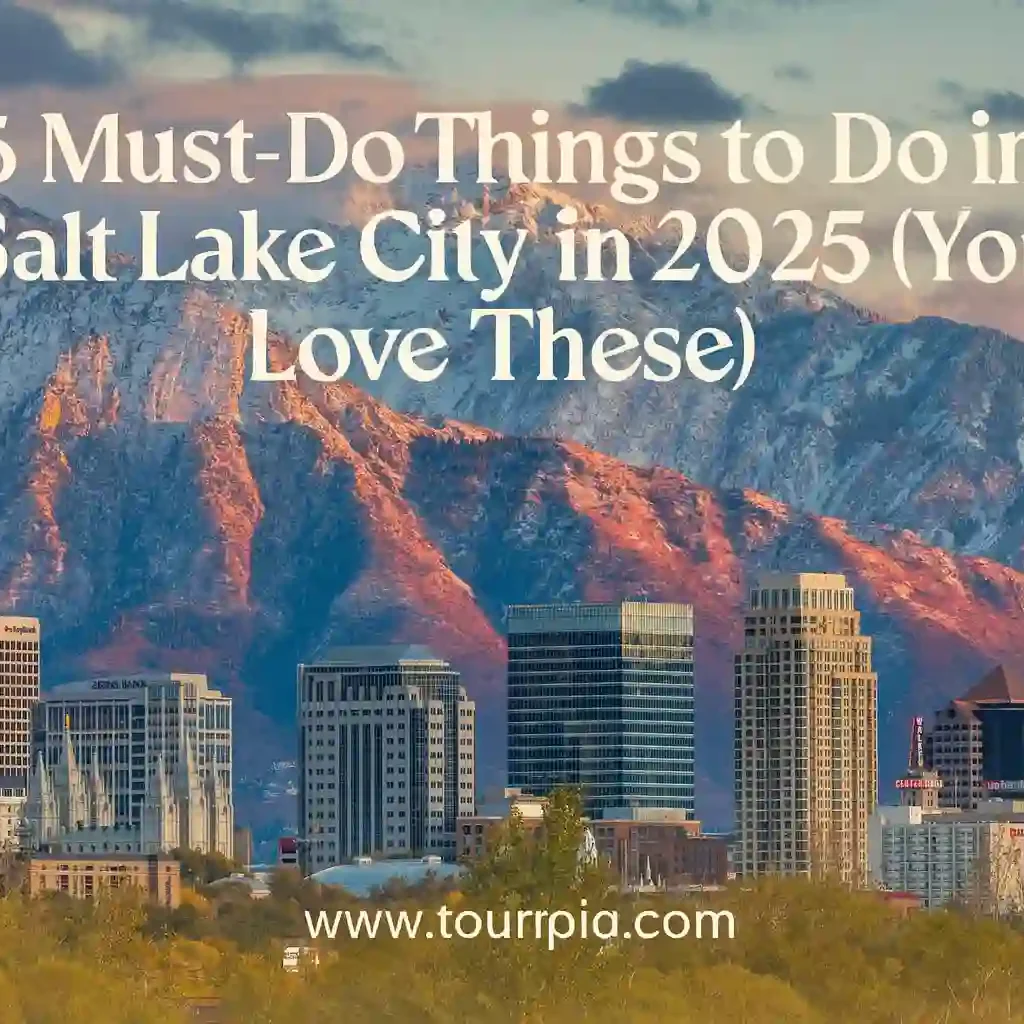Texas National Parks Guide: Big Bend, Guadalupe & 5 Hidden Trails

When travelers ask me about the most underrated landscapes in the United States, I point them toward this Texas National Parks Guide.
Few states pack in such variety—towering mountains, desert canyons, rivers that carve deep valleys, and coastlines where sea turtles nest. Texas doesn’t just surprise first-time visitors; it humbles even seasoned explorers who think they’ve seen it all.
My own trips across the Lone Star State—ranging from quiet hikes in the Chisos Mountains to late nights under the stars in the Chihuahuan Desert—taught me something simple: Texas holds a raw beauty that demands time and respect.
The National Park Service manages not only two official U.S. national parks here but also a network of historic trails, recreation areas, and preserves that rival anywhere else in the country.
In this Texas National Parks Guide, I’ll cover the crown jewels—Big Bend National Park and Guadalupe Mountains National Park—and also five lesser-known trails that most guidebooks skip.
Whether you’re searching for a downloadable Texas national parks guide pdf, a detailed Texas national parks guide map, or simply advice from someone who’s hiked these paths multiple times, you’ll find it here.
By the end, you’ll see why any serious park lover should plan a Texas trip here in 2025. Texas isn’t just another stop on the map—it’s an adventure that rewrites what you thought you knew about American wilderness.
This Texas National Parks Guide is your key to making the most of it.
Quick Overview of Texas National Parks & Protected Areas

Texas is home to just two official U.S. national parks—Big Bend and Guadalupe Mountains—but don’t let that number fool you.
There are over 80 federally protected sites here, ranging from historic battlefields and seashores to massive state parks managed by Texas Parks & Wildlife.
The landscapes vary wildly. You’ll find:
- Deserts in the far west, where the Rio Grande winds past steep canyon walls.
- Mountain ranges like the Guadalupe Mountains and Davis Mountains State Park.
- Prairies and rivers in the central plains, from the Guadalupe River to the Paluxy River.
- Coastlines like Padre Island National Seashore, where wind and tide shape endless beaches.
Timing matters. Spring brings carpets of wildflowers to the Hill Country, while fall paints McKittrick Canyon in fiery reds and oranges.
Summer can be brutally hot, especially in desert parks, and winter nights in the mountains can dip below freezing.
In my experience, the best time to visit Texas parks is spring or fall—fewer crowds, better weather, and more wildlife activity.
Whether you’re searching for a Texas State Parks Map, a Texas State Parks guide book, or even a free Texas State Parks guide, what matters most is knowing what type of landscape excites you.
Because in Texas, you can stand on a canyon rim at sunrise and by evening be driving into lush pine forests or sandy coastline.
1. Big Bend National Park: Texas’s Desert Jewel

If you’ve ever wondered how vast silence can feel, Big Bend will answer it. The park sits in remote West Texas, hugging a long stretch of the Rio Grande River that doubles as the U.S.–Mexico border.
It’s not a place you stumble upon—it requires intent. Driving here means hours of desert highways, gas stations few and far between, and a sudden realization that you’re heading into one of the wildest corners of America.
✔️ Exploring the Chisos Mountains & Desert Landscapes
The heart of Big Bend is the Chisos Mountain range, a volcanic uplift that rises sharply out of the desert. Trails here, like the Window Trail and the Lost Mine Trail, give hikers access to pine forests and cool breezes far above the hot desert floor.
Contrast that with the Chihuahuan Desert, where cactus, ocotillo, and mesquite stretch for miles under an unrelenting sun. It’s this mix of environments that makes Big Bend feel like three parks in one.
✔️ Iconic Trails Every Visitor Should Try
I’ve hiked nearly every major trail here, and a few always stand out:
- South Rim Trail – Long, challenging, but iconic. From its cliffs, the desert floor spreads endlessly, and on clear days you can see deep into Mexico.
- Santa Elena Canyon Trail – The Rio Grande has carved 1,500-foot walls here, and the echo of your voice bounces across the water. I kayaked once into the canyon, and paddling beneath those sheer walls was unforgettable.
- Lost Mine Trail – Ideal for beginners or families, this hike offers big rewards without the all-day grind. Sunrise here paints the canyon walls a deep gold.
- Hot Springs Historic Trail – An easy riverside walk that ends in hot springs, where I’ve soaked under starry skies after a long desert day.
✔️ Wildlife Encounters in Big Bend
Wildlife adds to the unpredictability of Big Bend. I’ve spotted roadrunners darting across dusty roads, watched javelinas forage in campsites, and even seen black bears return after decades of absence.
Birders love Big Bend because the park straddles a migration corridor; in spring, the Rio Grande area fills with colorful species.
Keep in mind: snakes, scorpions, and mountain lions also call this wilderness home. Staying alert is part of the experience.
✔️ Stargazing: An International Dark Sky Park
Few places in the U.S. rival Big Bend’s night skies. With no major city nearby, it’s one of the darkest regions on the continent.
I’ve laid on my back by the Rio Grande Wild & Scenic River and watched the Milky Way stretch overhead like a glowing ribbon.
If stargazing is on your bucket list, plan at least one night away from campfires or headlights.
✔️ Water-Based Adventures
Big Bend isn’t just about desert hiking—it’s also a paradise for water-based recreation. The Rio Grande River offers paddling routes ranging from a few hours to multi-day expeditions.
My favorite was a two-day float through Boquillas Canyon, where the mornings were calm, and evenings ended with campfires on sandy riverbanks.
Outfitters in nearby Terlingua can arrange guided trips if you’re not ready to navigate rapids solo.
✔️ Practical Travel Advice for Big Bend
- Lodging: Book the Chisos Mountain Lodge early or secure campsites in advance.
- Maps & Navigation: Cell service is unreliable—download a Texas National Parks guide map before entering.
- Timing: Spring and fall are best; summers can be dangerously hot, and winter nights dip below freezing.
- Packing: Always carry extra water, a wide-brim hat, and layers for temperature swings.
✔️ Personal Reflection
What stays with me most isn’t just the scenery—it’s the quiet. I remember hiking alone on the South Rim Trail, pausing to catch my breath, and realizing the only sound was the wind.
No planes, no highways, no voices. Just wilderness stretching to the horizon. That’s the essence of Big Bend—it strips away distractions and gives you the rare gift of stillness.
2. Guadalupe Mountains National Park: Rugged Wilderness of West Texas

Drive north from El Paso, and the desert highway eventually leads to towering limestone cliffs rising abruptly from the flatlands. This is Guadalupe Mountains National Park, home to the highest peak in Texas and one of the most intact fossilized reefs in the world.
It’s smaller and less visited than Big Bend, but to me, its remoteness is its gift. Here, you’ll find solitude, rugged trails, and landscapes that feel almost prehistoric.
✔️ Why Visit Guadalupe Mountains?
While Big Bend National Park dazzles with its mix of desert and river canyons, Guadalupe impresses with sheer vertical drama. Hiking into McKittrick Canyon, for example, feels like stepping into another state—lush forests tucked between desert cliffs.
In fall, I’ve walked beneath bright orange maples and golden cottonwoods, a sight that rivals New England foliage. Then there’s the challenge of climbing Guadalupe Peak, where at 8,751 feet you stand on “the top of Texas.”
Beyond the scenery, the park tells a story. The El Capitan formation, visible from miles away, was once part of a vast underwater reef some 260 million years ago. Standing at its base, I’ve often imagined the sea creatures that once thrived here before deserts claimed the land.
✔️ Top Trails & Hikes
Guadalupe is a hiker’s park. There are no scenic drives, so the only way to truly experience it is on foot. Some trails that stand out:
- Guadalupe Peak Trail – A strenuous 8.5-mile round trip with a 3,000-foot elevation gain. The metal pyramid at the summit is a reward, and on a clear day, you can see across the desert plains into New Mexico.
- Devil’s Hall Trail – Moderate difficulty, about 4.2 miles. You hike through a rocky wash that ends in a narrow canyon flanked by dramatic limestone walls. It’s one of the most photogenic spots in the park.
- McKittrick Canyon Trail – A must in autumn, this trail winds along a streambed shaded by trees that burst with color in October and November. Even outside fall, it’s a peaceful hike through a surprisingly green landscape.
- Bush Mountain Trail – If you crave solitude, this is it. At over 12 miles, it’s demanding, but the views across the Chihuahuan Desert reward every step.
✔️ Flora & Fauna
One reason I keep returning to Guadalupe Mountains is its unexpected biodiversity. On the same hike, you can pass through desert lowlands filled with agave and prickly pear, then climb into pine and Douglas fir forests near the summit.
Wildlife spotting is equally diverse: elk grazing in meadows, golden eagles circling cliffs, and smaller creatures like rock squirrels that always seem to beg for a photo.
✔️ Practical Tips for Visiting Guadalupe Mountains
- No Gas Stations: Fuel up in Van Horn or Carlsbad before entering. The park has no services.
- Weather Shifts Fast: I’ve started hikes in sunshine and finished in snow flurries. Always bring layers.
- Maps Are Essential: Cell service is spotty. Carry a printed Texas state park guide 2025 or download offline maps.
- Camping: Sites at Pine Springs and Dog Canyon fill up quickly in peak season, so book ahead.
- Accessibility: Trails are rugged; this isn’t a park for casual sightseeing from your car.
✔️ Cultural & Historical Context
Guadalupe Mountains is also rich in human history. The area once served as a crossroads for the Butterfield Overland Trail, and before that, it was home to Apache communities.
Nearby you’ll find connections to the El Camino Real de Tierra Adentro National Historic Trail, linking New Mexico to Mexico City.
Spending time here isn’t just about hiking—it’s about standing in landscapes that shaped trade, survival, and migration for centuries.
✔️ Insider Reflections
What I love most about Guadalupe is the sense of scale. Standing at the base of El Capitan, the cliffs dwarf you. Hiking the backcountry trails, you’ll often realize you haven’t seen another person in hours, maybe all day.
That kind of solitude is rare in the U.S., and it’s why I consider Guadalupe one of the last wild sanctuaries in Texas.
One evening, after climbing Guadalupe Peak, I camped near the trailhead. As the wind roared down from the cliffs, I cooked a simple dinner and watched the desert lights of New Mexico flicker faintly in the distance.
It was one of those moments where travel strips you back to basics—food, shelter, silence, and sky.
Helpful Read: Closest Airport to Zion National Park + 7 Nearby Options
5 Hidden Trails & Outdoor Gems in Texas

Not every great adventure in Texas is inside a national park. Some of the state’s best trails lie tucked inside lesser-known state parks and preserves.
These places rarely make the glossy brochures, but if you ask locals—or travelers like me who spend weeks chasing trails—you’ll hear names like Caprock Canyons or Gorman Falls whispered with admiration.
Here are five trails that deserve a place in any serious Texas National Parks Guide.
1. Caprock Canyons Trailway – Red Rock Wilderness & Bison Herds

Drive up into the Texas Panhandle, and suddenly you’ll discover a landscape painted in deep red hues. Caprock Canyons State Park is often called the “Little Grand Canyon of Texas,” though I’d argue it has its own character.
What struck me most was hiking through its red rock cliffs while a herd of free-roaming Texas bison wandered nearby—a sight that feels more like Yellowstone than West Texas.
- Trail Highlights: The Caprock Canyons Trailway spans over 60 miles of converted rail line, passing through tunnels, bridges, and canyon walls carved by the Canadian River. The Lighthouse Trail here (not to be confused with Palo Duro’s) is a moderate 6-mile hike with fantastic overlooks.
- Difficulty: Varies, but most sections are moderate with long stretches under the open sun.
- Best Season: Fall and spring. Summer heat can be punishing, and winter winds sweep fiercely across the plains.
- Insider Tip: Bring a camera and patience. The bison herd often blocks trails, and watching them roam against the canyon backdrop is worth the delay.
I once camped near the Trailway on a crisp October evening, and as the sun set, the cliffs glowed like embers.
The sound of bison moving in the distance reminded me just how wild Texas state parks can feel when left unspoiled.
Helpful Read: The Ultimate Texas Travel Guide: Best Places, Road Trips & Vacation Tips
2. Colorado Bend State Park (Gorman Falls Trail) – Waterfall Surprise in Hill Country

When most people think of Texas, waterfalls don’t come to mind. Yet tucked into Colorado Bend State Park is the Gorman Falls Trail, a 3-mile round trip that leads to one of the most spectacular waterfalls in the state.
The first time I reached it, I had to pause—the sight of water tumbling 70 feet down mossy limestone walls in the middle of the Hill Country felt surreal.
- Trail Highlights: The hike begins on rocky terrain but ends at a lush, almost tropical oasis. The Gorman Falls cascade creates a microclimate of ferns and moss, something rare in this part of Texas.
- Difficulty: Moderate. The trail can be slippery, especially near the falls, so sturdy hiking boots are a must.
- Best Season: Spring, when water flow is strongest and wildflowers bloom along the trail.
- Insider Tip: Many travelers stop at the falls and head back, but if you continue exploring, you’ll find hidden swimming holes along the Colorado River.
- I’ve cooled off in those waters after long summer hikes, and it’s one of my favorite memories in Central Texas.
Colorado Bend also offers cave tours and over 35 miles of trails, making it one of the most versatile and beautiful places in a Texas state parks travel guide.
If you’re building a road trip, this park pairs perfectly with nearby Blanco State Park and McKinney Falls State Park for a diverse Hill Country loop.
3. Palo Duro Canyon State Park (Lighthouse Trail) – The “Grand Canyon of Texas”

Locals call it the Grand Canyon of Texas, and for good reason. Palo Duro Canyon State Park, located near Amarillo, is the second-largest canyon in the U.S.
I’ve hiked and camped here several times, and every visit reminds me how vast and colorful this landscape is—red rock walls, rugged mesas, and the famous Lighthouse formation rising from the canyon floor.
- Trail Highlights: The Lighthouse Trail is a 6-mile round trip that takes you right to the park’s most iconic rock spire. The final climb is steep, but the view from the top is worth every step. From here, you can see the Canadian River basin stretching for miles.
- Difficulty: Moderate, but summer heat makes it feel harder. Start early, bring at least 2 liters of water, and wear a hat.
- Best Season: Spring and fall, when temperatures are manageable. Winters can be cold, but the canyon dusted with snow is a rare sight.
- Insider Tip: Stay for the Texas Outdoor Musical (summer only), performed in the canyon’s natural amphitheater. It’s touristy, but the setting under the stars makes it unforgettable.
On one hike, I took the Rock Garden Trail before sunrise and watched the canyon glow as light spilled across the cliffs.
It was a reminder that while national parks in Texas get much of the spotlight, the state parks here hold their own in terms of beauty and scale.
4. Enchanted Rock Summit Trail – Granite Dome with Panoramic Views

In the heart of the Texas Hill Country, north of Fredericksburg, rises a massive pink granite dome known as Enchanted Rock.
This place has been sacred to Native peoples for centuries, and even after multiple climbs, I still feel its quiet magic.
The Summit Trail is short—just 1.5 miles—but it’s steep, and reaching the top feels like walking on the back of a giant stone turtle.
- Trail Highlights: From the summit, the 360-degree views stretch across the Hill Country. On clear days, you can spot ranchlands, oak forests, and rolling hills fading into the horizon.
- Difficulty: Easy to moderate. Families often make the climb, though the incline can challenge those not used to steep hikes.
- Best Season: Spring is perfect, with wildflowers blooming at the base. Fall is cooler, and winter sunsets here are some of the best I’ve photographed.
- Insider Tip: Arrive early. Enchanted Rock is hugely popular, and the park often reaches capacity by mid-morning, especially on weekends. If you can, hike at dusk and watch the sky fade into stars—it’s also a recognized International Dark Sky Park.
For me, Enchanted Rock isn’t just a hike—it’s a meditation.
I once sat on the summit for hours, watching the shadows shift across the granite while the Guadalupe River basin shimmered in the distance.
That’s the beauty of Texas: in one trip, you can go from desert solitude in Big Bend National Park to the communal magic of watching the sun set on Enchanted Rock.
Helpful Read: 20+ Unique Things to Do in Texas for Families
5. Big Thicket National Preserve Trails – Biodiversity Hotspot in East Texas

If Big Bend is about desert silence and Guadalupe is about rugged peaks, then the Big Thicket National Preserve is about life in abundance.
Located in East Texas, this preserve is often overlooked in a typical Texas National Parks Guide, but it’s one of the most ecologically diverse areas in the U.S.
- Trail Highlights: With more than 40 miles of trails, you can choose from short boardwalks to longer hikes through dense pine and hardwood forests. The Kirby Nature Trail and Turkey Creek Trail are among my favorites. You’ll cross wetlands, sandy ridges, and streams that eventually feed into the Neches River.
- Difficulty: Easy to moderate, depending on the route. Trails are well-marked but can be muddy after rains.
- Best Season: Spring and early fall. Summers are humid, and mosquitoes are fierce.
- Insider Tip: Bring binoculars. The preserve is a hotspot for birdwatching, with woodpeckers, warblers, and even migratory waterfowl. Canoeing along the Neches River offers a completely different perspective of the park.
I’ll admit, the first time I walked through Big Thicket, I underestimated it. But the mix of orchids, carnivorous plants, and towering trees made me realize this wasn’t just a hike—it was a living classroom of biodiversity.
For those building a complete Texas parks guide, this preserve deserves a spot right beside the better-known parks.
How to Plan Your Texas National Park Road Trip

One of the most rewarding ways to experience these landscapes is by road.
Texas is massive—distances between parks can stretch for hours—so planning your itinerary is as important as choosing the right trail.
Over the years, I’ve crafted a few itineraries that balance time, energy, and highlights.
✔️ Suggested Itineraries
- 5-Day Itinerary: Big Bend Only
- Focus your trip on Big Bend National Park and its surrounding areas. Spend three days hiking the Chisos Mountains and Santa Elena Canyon, one day paddling the Rio Grande Wild & Scenic River, and one day exploring nearby Big Bend Ranch State Park for rugged desert beauty.
- 7-Day Itinerary: Big Bend + Guadalupe
- Start in El Paso, drive to Guadalupe Mountains National Park for two days of hiking (Guadalupe Peak Trail and McKittrick Canyon), then head south to Big Bend for four days. Leave the final day for travel between the parks—it’s a long haul, but worth it.
- 10-Day Extended Adventure
- Combine the above with a stop at Palo Duro Canyon State Park to hike the Lighthouse Trail, then swing through the Hill Country for a climb up Enchanted Rock or a visit to Colorado Bend State Park. Finish in East Texas with the Big Thicket National Preserve for a true cross-section of Texas’s ecosystems.
✔️ Road Trip Essentials
- Fuel & Food: Gas stations are sparse near Big Bend and Guadalupe—always top off before entering.
- Lodging: Book early. Options range from camping and rustic cabins to lodges inside select parks. If you want a Texas National Parks guide with cabins, check parks like Palo Duro and Caprock Canyons.
- Navigation: Cell service drops often—download offline maps or carry a printed Texas State Parks Map or Texas State Parks official guide.
- Timing: Spring and fall are best for mild weather and wildflowers. Summer is high heat season, especially in desert parks.
✔️ Packing List
From years of traveling across Texas’s wild spaces, here are the items I never skip:
- Hydration packs or large refillable bottles (water is scarce in desert parks).
- Hiking boots with solid grip for rocky terrain.
- A wide-brim hat and lightweight long sleeves for sun protection.
- Layered clothing—mountain mornings can be chilly even in summer.
- Park passes (consider the annual Texas state park pass for value).
Planning well turns a good trip into a great one. With the right gear, timing, and mindset, a Texas National Parks road trip becomes less about checking off sites and more about immersing yourself in landscapes that shift dramatically from desert to canyon to forest.
Responsible & Safe Travel in Texas Parks
Traveling through Texas’s wild landscapes comes with responsibility.
From the Chihuahuan Desert to the pine forests of the Big Thicket, every ecosystem is fragile and deserves respect.
- Leave No Trace: Pack out all trash, stay on marked trails, and avoid disturbing plants or wildlife. Areas like Santa Elena Canyon and McKittrick Canyon are particularly sensitive to erosion.
- Heat Safety: Summer temperatures can soar past 100°F in Big Bend and Palo Duro Canyon State Park. Always carry more water than you think you’ll need. I recommend at least one gallon per person per day.
- Wildlife Encounters: Mountain lions, rattlesnakes, and javelinas roam freely. Give them space. At Guadalupe Mountains National Park, I once encountered a rattlesnake sunning itself across the Devil’s Hall Trail—patience and distance kept the moment safe.
- Fire Safety: Texas parks often enter burn bans. In dry areas like Caprock Canyons or Davis Mountains State Park, never assume fires are allowed without checking current rules.
If you’re carrying a Texas state parks official guide, you’ll find safety reminders built in.
But the most important thing is respect—for the land, the people, and the history tied to every canyon and river.
Conclusion: The Wild Soul of Texas Outdoors
Every trip I’ve taken across Texas parks has reminded me why the Lone Star State belongs in any serious Texas National Parks Guide. From the desert silence of Big Bend to the rugged heights of Guadalupe Peak, Texas doesn’t just show you beauty—it immerses you in it.
The hidden trails—Caprock Canyons, Colorado Bend, Palo Duro Canyon, Enchanted Rock, and the Big Thicket—add a depth that even seasoned travelers might not expect. Together, they paint a picture of a state that refuses to be one thing.
If you’re building your 2025 adventure list, Texas deserves a place at the top. Plan smart, travel respectfully, and give yourself the time to experience both the icons and the lesser-known gems.
This Texas National Parks Guide isn’t just about maps or trails—it’s an invitation to explore the wild soul of a state that surprises at every turn.
Frequently Asked Questions
1. How many national parks are in Texas?
Two official U.S. national parks: Big Bend and Guadalupe Mountains, plus more than 80 protected sites.
2. When is the best time to visit Big Bend or Guadalupe?
Spring and fall. Mild weather, wildflowers, and lighter crowds make these months ideal.
3. Are Texas parks family-friendly?
Yes—parks like Enchanted Rock and McKinney Falls State Park have trails suited for kids, while Big Bend offers short hikes like the Hot Springs Historic Trail.
4. Do I need permits for hikes?
Most day hikes don’t require permits, but backcountry camping in Big Bend National Park and certain paddling trips on the Rio Grande do.
5. Is camping safe in Big Bend?
Yes, but follow guidelines. Wildlife roams freely, so store food properly and never hike alone at night.
6. Which Texas national park is better?
It depends—Big Bend for desert canyons and rivers, Guadalupe Mountains for rugged peaks and fossils.
7. What is the most beautiful park in Texas?
Subjective, but many argue Big Bend for landscapes and McKittrick Canyon for fall colors.
8. How many national parks are there in TX?
Two official national parks, but if you include historic sites and recreation areas, the list grows dramatically.
9. What is the most visited national park in Texas?
Big Bend National Park consistently sees more visitors, though Palo Duro Canyon State Park rivals it in popularity.
10. What is the number one tourist spot in Texas?
For outdoor lovers, it’s Big Bend. But overall, attractions like the San Antonio Missions National Historical Park and Padre Island National Seashore draw huge crowds too.
11. Can you drive through Big Bend in a day?
Technically yes, but it’s too vast to truly appreciate in one day. Spend at least three to four days if you can.
Recent Posts
 Tubeseferi: 7 Must-Know Features for Smart City Travel in 2025
Tubeseferi: 7 Must-Know Features for Smart City Travel in 2025 What Is Antolohe? Hidden Travel Meaning Revealed for 2025
What Is Antolohe? Hidden Travel Meaning Revealed for 2025 How to Become a Travel Agent Without Experience?
How to Become a Travel Agent Without Experience? 15 Best Airlines for Long Flights in 2025: Comfort, Cuisine, and Sky-High Service
15 Best Airlines for Long Flights in 2025: Comfort, Cuisine, and Sky-High Service Day Trips from Buenos Aires: Surprising Routes Off the Tourist Trail
Day Trips from Buenos Aires: Surprising Routes Off the Tourist Trail













